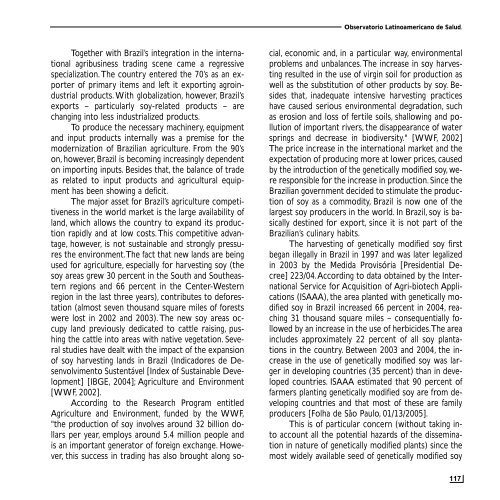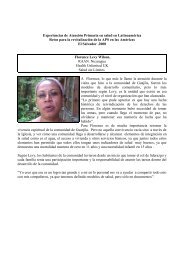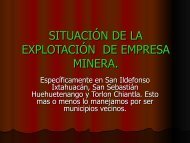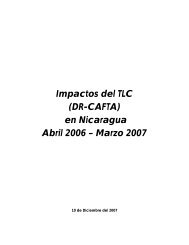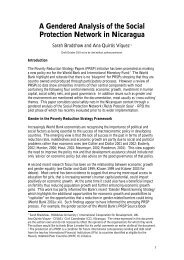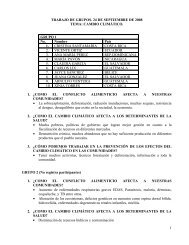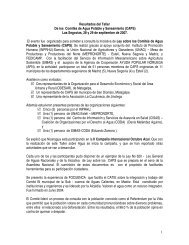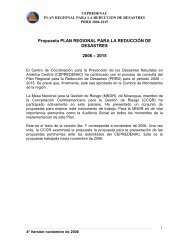Download - CISAS | Centro de Información y Servicios de AsesorÃa ...
Download - CISAS | Centro de Información y Servicios de AsesorÃa ...
Download - CISAS | Centro de Información y Servicios de AsesorÃa ...
Create successful ePaper yourself
Turn your PDF publications into a flip-book with our unique Google optimized e-Paper software.
Observatorio Latinoamericano <strong>de</strong> Salud.Together with Brazil’s integration in the internationalagribusiness trading scene came a regressivespecialization.The country entered the 70’s as an exporterof primary items and left it exporting agroindustrialproducts. With globalization, however, Brazil’sexports – particularly soy-related products – arechanging into less industrialized products.To produce the necessary machinery, equipmentand input products internally was a premise for themo<strong>de</strong>rnization of Brazilian agriculture. From the 90’son, however, Brazil is becoming increasingly <strong>de</strong>pen<strong>de</strong>nton importing inputs. Besi<strong>de</strong>s that, the balance of tra<strong>de</strong>as related to input products and agricultural equipmenthas been showing a <strong>de</strong>ficit.The major asset for Brazil’s agriculture competitivenessin the world market is the large availability ofland, which allows the country to expand its productionrapidly and at low costs.This competitive advantage,however, is not sustainable and strongly pressuresthe environment.The fact that new lands are beingused for agriculture, especially for harvesting soy (thesoy areas grew 30 percent in the South and Southeasternregions and 66 percent in the Center-Westernregion in the last three years), contributes to <strong>de</strong>forestation(almost seven thousand square miles of forestswere lost in 2002 and 2003). The new soy areas occupyland previously <strong>de</strong>dicated to cattle raising, pushingthe cattle into areas with native vegetation. Severalstudies have <strong>de</strong>alt with the impact of the expansionof soy harvesting lands in Brazil (Indicadores <strong>de</strong> DesenvolvimentoSustentável [In<strong>de</strong>x of Sustainable Development][IBGE, 2004]; Agriculture and Environment[WWF, 2002].According to the Research Program entitledAgriculture and Environment, fun<strong>de</strong>d by the WWF,"the production of soy involves around 32 billion dollarsper year, employs around 5.4 million people andis an important generator of foreign exchange. However,this success in trading has also brought along social,economic and, in a particular way, environmentalproblems and unbalances.The increase in soy harvestingresulted in the use of virgin soil for production aswell as the substitution of other products by soy. Besi<strong>de</strong>sthat, ina<strong>de</strong>quate intensive harvesting practiceshave caused serious environmental <strong>de</strong>gradation, suchas erosion and loss of fertile soils, shallowing and pollutionof important rivers, the disappearance of watersprings and <strong>de</strong>crease in biodiversity." [WWF, 2002]The price increase in the international market and theexpectation of producing more at lower prices, causedby the introduction of the genetically modified soy, wereresponsible for the increase in production. Since theBrazilian government <strong>de</strong>ci<strong>de</strong>d to stimulate the productionof soy as a commodity, Brazil is now one of thelargest soy producers in the world. In Brazil, soy is basically<strong>de</strong>stined for export, since it is not part of theBrazilian’s culinary habits.The harvesting of genetically modified soy firstbegan illegally in Brazil in 1997 and was later legalizedin 2003 by the Medida Provisória [Presi<strong>de</strong>ntial Decree]223/04.According to data obtained by the InternationalService for Acquisition of Agri-biotech Applications(ISAAA), the area planted with genetically modifiedsoy in Brazil increased 66 percent in 2004, reaching31 thousand square miles – consequentially followedby an increase in the use of herbici<strong>de</strong>s.The areainclu<strong>de</strong>s approximately 22 percent of all soy plantationsin the country. Between 2003 and 2004, the increasein the use of genetically modified soy was largerin <strong>de</strong>veloping countries (35 percent) than in <strong>de</strong>velopedcountries. ISAAA estimated that 90 percent offarmers planting genetically modified soy are from <strong>de</strong>velopingcountries and that most of these are familyproducers [Folha <strong>de</strong> São Paulo, 01/13/2005].This is of particular concern (without taking intoaccount all the potential hazards of the disseminationin nature of genetically modified plants) since themost wi<strong>de</strong>ly available seed of genetically modified soy117


